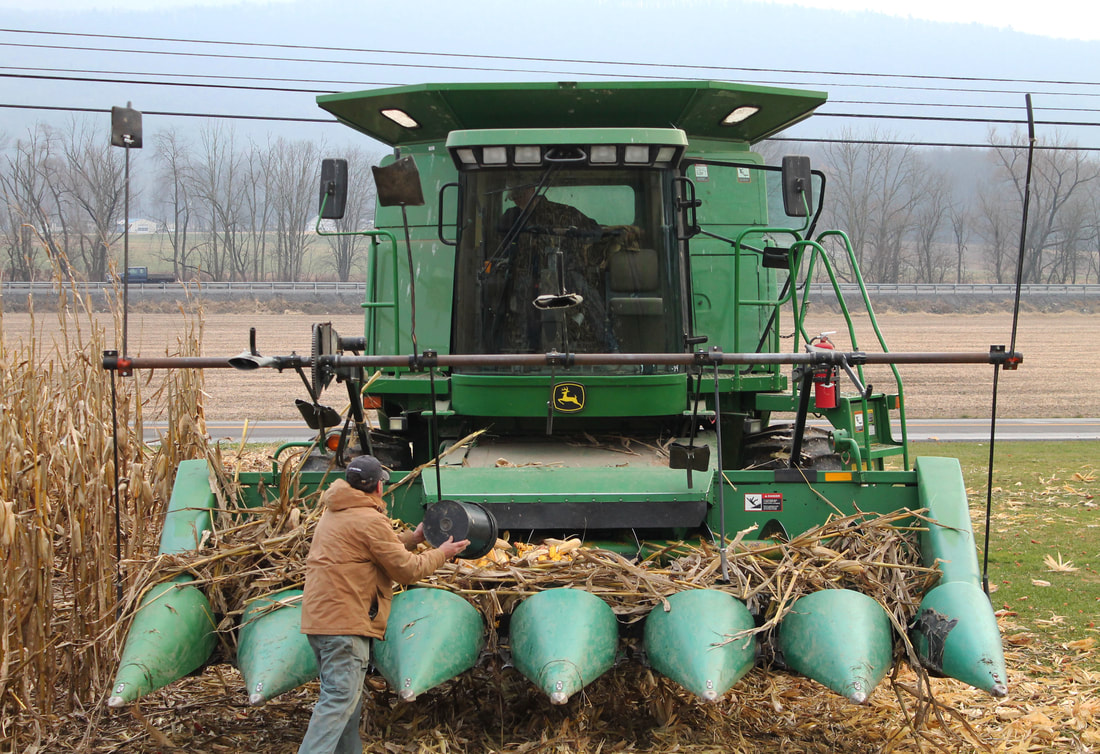Fortunately we didn't accumulate much rainfall or snow last week, but many sections of our fields are still saturated. Even though we've experienced a few frosts, the top layer thaws with the daylight hours, so when heavy machinery like our combine rolls over it, there is a risk of sinking, getting stuck or even toppling on hilly ground. What slows us down the most is that much of our field corn has fallen over and is almost flush with the ground, which makes it impossible for the combine to simply roll through the fields. Most days Mark is in the combine while one or two of us are alongside of it, actually husking the ears by hand at times and tossing them into the machine to shell it. My father-in-law has already ruined a few pairs of gloves. What absolute misery.
Field corn is different from sweet corn, which is what we harvest in the summer and early fall to sell at farmers markets. Field corn is obviously edible because it's what we grow as grain to feed to livestock, but it's not something you want to eat off the cob unless you're looking to chip a tooth. Field corn is left until late fall to mature and dry out first before harvesting. There are two different ways we harvest field corn: picking and shelling.
When a farmer refers to "picking corn," he or she is talking about using a machine called a corn picker (appropriately named, right?) that snaps the ears from a corn stalk. All of the kernels, including the cob, are harvested this way. The mechanical pickers used to do this are not as commonly used as they once were because it takes much longer to harvest than with a combine and the process is more dangerous. However we still pick a lot of corn because the feed it creates is much more nutritious.
"Shelling corn" refers to using a combine, which is what most people associate with corn harvest. Combines are the giant, transformer-like machines that can be used to harvest a variety of crops from corn to wheat to soybeans. When a combine is used to harvest corn, it extracts only the kernels from the cobs. The stalks, leaves, husks and cobs are separated from the corn kernels, ground up and scattered in the field. The combine is arguably one of the most economical pieces of equipment on a crop farm because it performs so many tasks.
By this time most farms in our area are either done with corn harvest or nearing the end, but corn harvest always lasts a little bit longer for us. Our operation is a bit more complex because of how many potatoes we grow. But Mark always says, even during times of high stress, that he feels fortunate to always have a job to do. I tend to view work as something that has to be done so you can do something you want to do. But over time, I'm coming around to appreciate his clever perspective. It reminds me of this verse from Thessalonians:
You should mind your own business
and work with your hands, just as we told you,
so that your daily life may win the respect of outsiders
and so that you will not be dependent on anybody.
1 Thessalonians 4: 11-12
Corn Cookies
Recipe from Christina Tosi via The Kitchn
Makes 12
| Ingredients 16 tbsp (225, 2 sticks) unsalted butter, room temperature 1 1/2 cups (300 g) sugar 1 large egg 1 1/3 cups (225 g) all purpose flour 1/4 cup (45 g) corn flour 2/3 cup (65 g) freeze dried corn powder 3/4 tsp (3 g) baking powder 1/4 tsp (1 1/2 g ) baking soda 1 1/2 tsp (6 g) kosher salt | Method Combine the butter and sugar in the bowl of a stand mixer fitted with the paddle attachment and cream together on medium-high for 2 to 3 minutes. Scrape down the sides of the bowl, add the egg, and beat for 7 to 8 minutes. Reduce the mixer speed to low and add the flour, corn flour, corn powder, baking powder, baking soda, and salt. Mix just until the dough comes together, no longer than 1 minute. Scrape down the sides of the bowl. Using a 2 3/4-ounce ice cream scoop (or a 1/3-cup measure), portion out the dough onto a parchment-lined baking sheet. Pat the tops of the cookie dough domes flat. Wrap the sheet pan tightly in plastic wrap and refrigerate for at least 1 hour, or up to 1 week. Do not bake your cookies from room temperature-- they will not bake properly. Heat the oven to 350°F. Arrange the chilled dough a minimum of 4 inches apart on parchment- or Silpat-lined sheet pans. Bake for 18 minutes. The cookies will puff, crackle, and spread. After 18 minutes, they should be faintly browned on the edges yet still bright yellow in the center; give them an extra minute if not. Cool the cookies completely on the sheet pans before transferring to a plate or to an airtight container for storage. |









 RSS Feed
RSS Feed
